|
Citroen C3
Debut: 2002
Maker: Citroen
Predecessor: no |
|
 In
the era of rationalization, we are pleased to see the introduction of
Citroen
C3 - a car that really breaks the mold. No other mini cars have such a
strong visual impact to the passers-by. The C3 looks like a modern
interpretation
of 2CV, thanks to its arc-shaped roofline. This profile signals a
change
of design theme for the French company - from the boxy shape of BX / AX
/ ZX / XM / Xsara back to the round shape of 2CV / DS / GS / CX.
Undoubtedly,
the latter was the golden era of Citroen. In
the era of rationalization, we are pleased to see the introduction of
Citroen
C3 - a car that really breaks the mold. No other mini cars have such a
strong visual impact to the passers-by. The C3 looks like a modern
interpretation
of 2CV, thanks to its arc-shaped roofline. This profile signals a
change
of design theme for the French company - from the boxy shape of BX / AX
/ ZX / XM / Xsara back to the round shape of 2CV / DS / GS / CX.
Undoubtedly,
the latter was the golden era of Citroen.
The
C3 looks like
a modern
classic rather than a cheap mini car as it is. It has real presence on
road, giving observers an impression that bigger than it is.
Ridiculously,
it even looks classier than the C5, thanks to the attention to details
at the grille, headlamps and front bumper.
However,
unlike
other reborn
classics such as New Mini and Beetle, the C3 did not sacrifice
practicality
for niche looks. In fact, it is one of the roomiest mini cars today,
just
shy of Honda Fit. Thanks to long wheelbase, high roof and cab-forward
windscreen,
the C3 offers generous space for all passengers, especially headroom.
Theatre-style
seating (front occupants sit high but rear passengers higher still)
plus
huge windows give the cabin an airy feel. Front legroom is first class,
while rear legroom is sufficient, if not remarkable. The luggage
compartment
carries a class-leading 305 litres of luggage and have a flexible
parcel
shelf called "Moduboard", but I think AutoZine’s readers will not be
too
interested in how it works.
The
unconventional design
also spreads to the dashboard. Facing the driver is a LCD digital
speedometer
and an arc-shaped analogue rev counter. Silver eyeball ventilation is
another
nice detail. Two-tone curvy dashboard with a simple center console
enhance
the pleasing ambience. The downside is cheap plastic used. PSA group
seems
not really care about this. As you can see, cheap plastics do not
prevent
Peugeot 206 from being the best seller in class.
In various
road
tests, faulty
build quality was found in the cabin thus gave testers bad impression.
However, as the car is built in the same plants as Peugeot 206, I am
optimistic
that the problem will be solved once entering production.
It is amazing
that such a
special car is actually built on the mechanicals of Peugeot 206, well,
maybe loosely based on. PSA’s platform sharing strategy is not as
strict
as Volkswagen. It allows cars to have different floorpan and chassis,
but
major systems - suspensions, engines, transmissions, brakes,
electronics
and equipment - which contribute to large portion of production cost
are
shared. Therefore the C3 gets different chassis, exterior and interior
packaging to make it unlike Peugeot 206. However, as the Citroen is
younger
than the Peugeot by 3 and a half years, it gets some systems newer than
that being used by the 206. For example, an electric power steering
(lighter
and eats less power than hydraulic one), multiplex wiring (saves a lot
of signal wires and connections and up reliability) and a new
generation
1.4-litre common-rail turbo diesel engine. These things will eventually
be used in the next Peugeot 207, so maybe we can see the C3’s
underpinnings
as equivalent to 206.5.
But
206.5 is not
necessarily
better than 206, because the Citroen has higher center of gravity and
carry
30kg more than a 206 with the same engine. These are what you pay for
"modern"
super minis - every generation gets taller and heavier, hence poorer
handling,
and you might be well prepared to accept that.
We
talk about
performance
first. Powering the C3 is either the existing 110hp 1.6-litre 16V, 75hp
1.4-litre 8V or the aforementioned 70hp 1.4-litre 8V turbo diesel. The
first one still provide respectable performance (0-60 in around 10
seconds),
although not as hot as Peugeot 206XSi which uses the same engine. This
is a torquey engine, but running at above 5000rpm will sound coarse.
Both
1.4-litre petrol and diesel are too slow (0-60 take more than 13 and 14
seconds respectively), however, at least the diesel has a useful 111
lbft
of torque for good tractability. Refinement and quietness of the
common-rail
diesel are also remarkable, not to mention its 67.2mpg combined
consumption.
Moreover, by employing aluminium head and block it actually lightens
the
nose. If not so slow, it would have been the best of the bunch.
The best will
come later
this summer: a beefed up version of the 1.4 diesel. With VTG turbo,
intercooler
and a 16V head, this version will generate 92 horsepower and 147 lbft.
This can be easily the best diesel engine for the class.
Concerning
chassis, you might
notice that since Picasso and C5 the company biases towards the comfort
side, leaving the excitement side to Peugeot. This somewhat conflicts
with
Citroen’s rally car program. Anyway, most customers will be satisfied
with
the safe and easy handling of C3. Slick gearchange, light steering,
supple
ride, good noise insulation and quiet cruising all contribute to its
comfortable
and easy-going character. The downside is that its lifeless steering
and
excessive body roll prevent the driver from pushing it to the limit. In
other words, C3 is by no means a driver’s car.
So what ?
remember, the double-arrow
badge has never meant to be sporty (forget the Saxo, a rebadged Peugeot
106). Since 2CV, Citroen’s core value was always comfort, practicality
and character. The C3 fulfills these 3 requirements. It is a worthy
successor
to 2CV. |
| The
above report was last updated on 22 Mar
2002. All Rights Reserved. |
C3 Pluriel
|
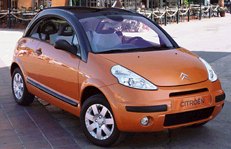 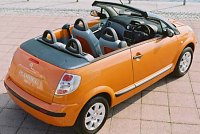 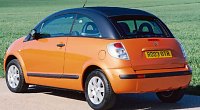
See
the pictures, this is probably the most versatile car ever appeared!
the
name "Pluriel" means "several", implying its multi-configurations -
conventional
hatchback, panoramic hatch, cabriolet, spider and pick-up. Let’s see
how
it works:
The
Pluriel is
normally a
conventional hatchback with a 2CV-style canvas roof. By pressing a
button,
the full-length electric soft roof slides back in 10 seconds to reveal
a panoramic view. If you want more fresh air and freer ambience, you
can
drop the frameless and pillarless side windows, flip and store the
fabric
roof and rear window manually into a storage space under the luggage
floor.
Now what you get is a cabriolet, albeit the thick roof rails. Next
stage
is more complex. To convert it into a spider (or roadster), you must
unlatch
and detach the roof rails, each weighing 12kg. Unfortunately, you must
leave them at home and, once they are detached, you cannot close the
roof
again. That means in spider mode you get zero weather protection. To
attach
the roof rails back to the car takes some work, because the latches are
difficult to locate and seem quite fragile. Finally, the Pluriel can be
converted into a little pick-up if you need to carry long luggage, such
as surf boards and mountain bikes. This can be done by dropping down
the
bottom-hinged tailgate and folding down the rear seats.
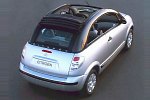
|
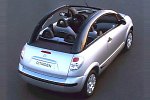
|
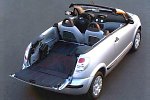
|
|
Panoramic
hatch
|
Cabriolet
|
Pick-up
|
To compensate
the
loss of
chassis rigidity, Pluriel has its sills and windscreen pillars
strengthened.
Roll-over bars are incorporated in the rear seats as a safety measure.
The interior is purely C3, with funky design and good space for the
front
occupants. Rear passengers are offered with limited legroom but the
Pluriel
is still a decent 4-seater compare with Peugeot 206CC.
Apart from the
roof and storage
architecture, Pluriel differs from the regular C3 by its cute styling.
More so than a Volkswagen new Beetle, it is deliberately designed to
deliver
a fun, colorful and youthful image. People who drive the Pluriel will
appreciate
its easy-to-drive manner - supple ride, light steering, torquey engine
and smooth-shifting Sensodrive semi-automatic gearbox. They are
unlikely
to criticize its lack of steering feel (again, blame the electric power
steering), the unremarkable performance (Pluriel is about 120-150kg
heavier
than the C3 with equivalent engines) and the lack of chassis stiffness.
On bumpy surfaces chassis flexing and shake is obvious, steering wheel
vibrates in the driver’s hands and the roof structure makes creaks and
rattles. But that is tolerable to those who love to drive it slowly to
enjoy fresh air and sunshine. Those who buy Pluriel are likely to be
attracted
by its funky image, flexibility and open air motoring. At this moment,
nothing else can offer these elements, no matter at what price. Citroen
hopes to find 75,000 customers annually, which is unusually ambitious
for
a niche model.
|
| The
above report was last updated on 25 Jun
2003. All Rights Reserved. |
|
|